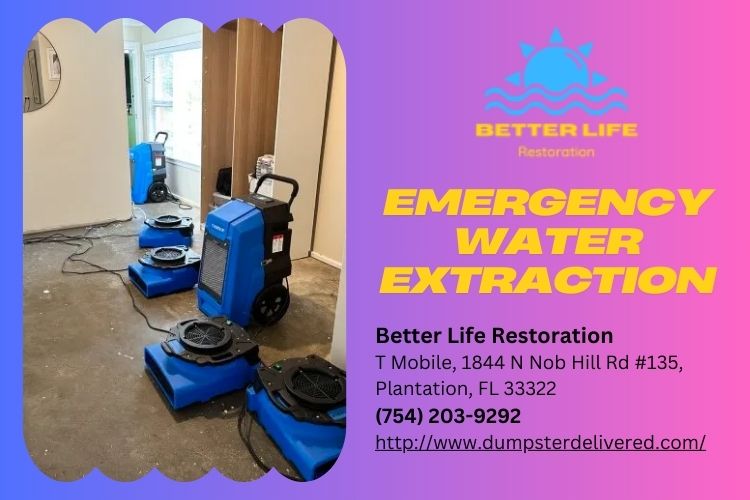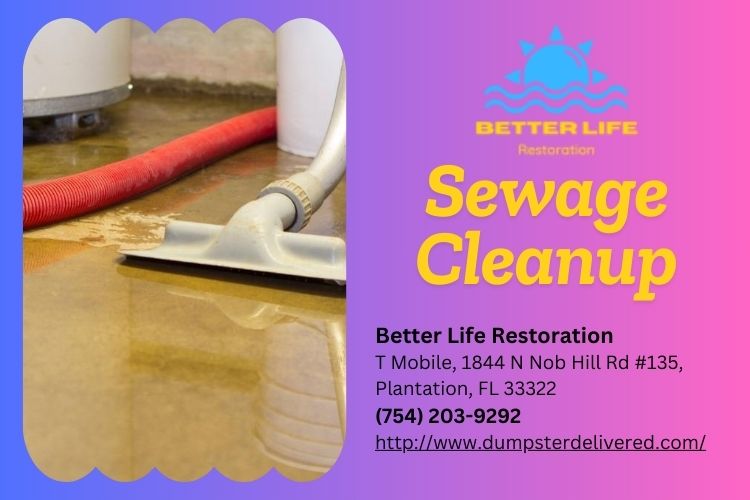Introduction
Water damage can be a daunting experience for anyone, especially for new residents of Plantation, Florida. With the area's tropical climate and frequent rainstorms, understanding how to deal with water-related issues is crucial. This guide aims to provide you with a thorough understanding of water damage restoration services available in Plantation, FL, focusing on flood damage restoration and water damage restoration techniques. Whether you're facing minor leaks or significant flooding, Better Life Restoration is here to help you navigate these challenges.
Understanding Water Damage
What is Water Damage?
Water damage refers to the destruction caused by water intruding into areas where it can cause harm. This can occur from various sources, including:
- Heavy Rainfall: Seasonal storms can bring intense rainfall leading to flooding. Leaking Pipes: Aging plumbing systems often lead to leaks in homes. Appliance Malfunctions: Issues with washing machines, dishwashers, or refrigerators can result in substantial water loss.
Types of Water Damage
There are three main categories of water damage:
Clean Water Damage: Originates from clean sources like broken pipes or malfunctioning appliances. Grey Water Damage: Comes from sources that are slightly contaminated such as washing machine overflow or toilet overflow (not sewage). Black Water Damage: Contains harmful bacteria and is typically the result of sewage backups or flooding from rivers.Signs of Water Damage
Identifying water damage early can prevent further complications. Look for:
- Stains on ceilings or walls Peeling paint or wallpaper Musty odors indicative of mold growth Warped floors or cabinetry
A Comprehensive Guide to Flood Damage Restoration
What is Flood Damage Restoration?
Flood damage restoration involves cleaning up and repairing property after a flood event. It includes several steps that should be taken quickly to minimize long-term effects.
Steps Involved in Flood Damage Restoration
1. Assessment
The first step involves assessing the extent of the damage. Experts will evaluate affected areas and determine what items can be salvaged.
2. Water Extraction
Using specialized equipment like pumps and vacuums, professionals will remove standing water quickly.
3. Drying
Once the water is removed, drying equipment such as dehumidifiers and air movers will help eliminate moisture from surfaces.
4. Cleaning and Sanitizing
All affected items need thorough cleaning and sanitization to remove contaminants and prevent mold growth.
5. Restoration
Finally, any damaged materials such as drywall or flooring may need replacement, restoring your home back to its pre-damage condition.
The Importance of Timely Intervention
Why Act Quickly After Water Damage Occurs?
Time is crucial when dealing with water-related issues. The longer you wait:
- The more extensive the damage becomes. There’s a higher risk for mold growth. Repair costs tend to increase significantly.
How Quickly Should You Call for Help?
Experts recommend contacting a professional restoration service within 24 hours after discovering water damage. Better Life Restoration specializes in prompt responses that mitigate further problems.
Choosing the Right Restoration Company
What Should You Look For in a Water Damage Restoration Service?
When selecting a company for your needs, consider:
- Experience in handling similar situations Availability (24/7 response) Reviews and testimonials from past clients
Better Life Restoration: Your Trusted Partner
Better Life Restoration has years of experience serving residents in Plantation, FL. Our team understands local conditions and is equipped with state-of-the-art tools necessary for effective flood damage restoration and overall water damage restoration services.
Insurance Considerations
Does Homeowners Insurance Cover Water Damage?
Many homeowners' insurance policies cover certain types of water damage but not all situations are included automatically:
- Most policies cover sudden incidents like burst pipes but may exclude flooding caused by natural disasters unless additional coverage is purchased.
Tips for Filing an Insurance Claim
Document all damages with photographs. Keep records of expenses related to temporary housing while repairs are made. Promptly report the incident to your insurance provider.Preventative Measures for Future Water Damage
Regular Maintenance Checks
Routine checks can help identify potential risks before they become significant problems:
- Inspect plumbing regularly for leaks. Ensure gutters are clean and functioning properly.
Installing Sump Pumps
Consider installing sump pumps in basements or crawl spaces prone to flooding as an effective preventative measure against excess water accumulation.

Common Myths About Water Damage
Myth #1: All Water Is Safe Until Proven Otherwise
Not all water is created equal; many assume that if it looks clear it's safe—this isn't always true!
Myth #2: A Little Mold Is Harmless
Ignoring small patches of mold can lead to serious health issues over time if not addressed properly.
FAQs about Water Damage Restoration
Q1: How long does it take to restore my home after flood damage?
A: The timeline varies based on severity but expect anywhere from several days up to weeks depending on damages sustained.
Q2: Can I handle minor water damages myself?
A: While small leaks may seem manageable initially, hiring professionals ensures comprehensive treatment preventing future issues such as mold growth.
Q3: How do I know if my home has hidden moisture issues?
A: Use moisture meters or consult professionals who utilize infrared cameras capable of detecting hidden dampness behind walls or under flooring.
Q4: Will my belongings be salvageable after severe flooding?
A: Many items can potentially be saved; however, this largely depends on material types as well as duration submerged underwater—prompt action improves chances significantly!
Q5: Is it safe to return home immediately after a flood?
A: Safety must come first! Always wait until authorities declare structures safe before re-entering any flooded premises due diligence should also include checking electrical systems prior returning inside homes affected by floods!
Q6: What type of equipment do professionals use during restoration?
A: Technicians utilize industrial-grade pumps & vacuums along with specialized drying tools like dehumidifiers & air movers designed specifically for efficient removal moisture excesses post-water incidents!
Conclusion
Navigating through the complexities associated with water damage restoration can be overwhelming—especially if you're new to Plantation, FL! Understanding what steps you need take following an incident helps ensure swift recovery while protecting your property against future occurrences too! Remember that Better Life Restoration stands ready at your side every step along way providing expertise needed effectively handle both flood damage restoration & general concerns surrounding overall quality living environments free from unwanted moisture threats affecting homes locally!
In closing, being proactive about prevention while knowing whom contact during emergencies makes all difference when faced unexpected challenges arise due nature's unpredictable tendencies! Stay informed & don’t hesitate reach out us today should questions arise regarding specific situations concerning potential risks associated living beautiful sunny skies here in our warm Flood Damage Restoration Plantation community nestled Florida's vibrant landscape!
Contact Us
Better Life Restoration
Address: T Mobile, 1844 N Nob Hill Rd #135, Plantation, FL 33322
Phone number: (754) 203-9292

